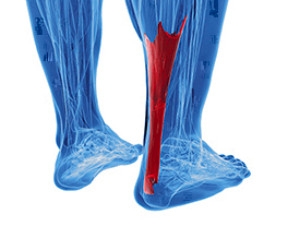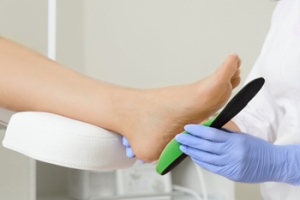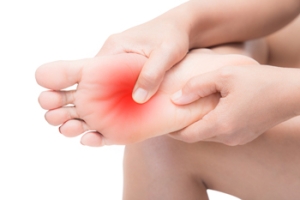
Types of Achilles Tendon Injuries
 The Achilles tendon is the band located on the back of the leg and is responsible for connecting the calf to the heel bone. This tendon is responsible for allowing us to rise up on our toes and for us to push off when walking or running. There are 2 main types of injuries that can occur to the Achilles tendon. The first, known as Achilles tendinopathy, occurs when there are tiny tears in the tendon and around it, usually from overuse. The second injury, an Achilles tendon rupture, can cause sudden pain and loss of movement. This is usually caused by a sudden movement or force that stresses the calf muscle. Patients who are experiencing pain in their Achilles tendon should consult with a podiatrist because of the potential severity these injuries have. A podiatrist will examine the leg and determine the extent of the injury.
The Achilles tendon is the band located on the back of the leg and is responsible for connecting the calf to the heel bone. This tendon is responsible for allowing us to rise up on our toes and for us to push off when walking or running. There are 2 main types of injuries that can occur to the Achilles tendon. The first, known as Achilles tendinopathy, occurs when there are tiny tears in the tendon and around it, usually from overuse. The second injury, an Achilles tendon rupture, can cause sudden pain and loss of movement. This is usually caused by a sudden movement or force that stresses the calf muscle. Patients who are experiencing pain in their Achilles tendon should consult with a podiatrist because of the potential severity these injuries have. A podiatrist will examine the leg and determine the extent of the injury.
Achilles tendon injuries need immediate attention to avoid future complications. If you have any concerns, contact one of our podiatrists of Ankle & Foot Care Center. Our doctors can provide the care you need to keep you pain-free and on your feet.
What Is the Achilles Tendon?
The Achilles tendon is a tendon that connects the lower leg muscles and calf to the heel of the foot. It is the strongest tendon in the human body and is essential for making movement possible. Because this tendon is such an integral part of the body, any injuries to it can create immense difficulties and should immediately be presented to a doctor.
What Are the Symptoms of an Achilles Tendon Injury?
There are various types of injuries that can affect the Achilles tendon. The two most common injuries are Achilles tendinitis and ruptures of the tendon.
Achilles Tendinitis Symptoms
- Inflammation
- Dull to severe pain
- Increased blood flow to the tendon
- Thickening of the tendon
Rupture Symptoms
- Extreme pain and swelling in the foot
- Total immobility
Treatment and Prevention
Achilles tendon injuries are diagnosed by a thorough physical evaluation, which can include an MRI. Treatment involves rest, physical therapy, and in some cases, surgery. However, various preventative measures can be taken to avoid these injuries, such as:
- Thorough stretching of the tendon before and after exercise
- Strengthening exercises like calf raises, squats, leg curls, leg extensions, leg raises, lunges, and leg presses
If you have any questions please feel free to contact our office located in Jupiter, FL . We offer the newest diagnostic tools and technology to treat your foot and ankle needs.
What are Achilles Tendon Injuries
The Achilles tendon is the strongest tendon in the human body. Its purpose is to connect the lower leg muscles and calf to the heel of the foot. This tendon is responsible for facilitating all types of movement, like walking and running. This tendon provides an enormous amount of mobility for the body. Any injuries inflicted to this tissue should be immediately brought up with a physician to prevent further damage.
The most common injuries that can trouble the Achilles tendon are tendon ruptures and Achilles tendinitis. Achilles tendinitis is the milder of the two injuries. It can be recognized by the following symptoms: inflammation, dull-to-severe pain, increased blood flow to the tendon, thickening of the tendon, and slower movement time. Tendinitis can be treated via several methods and is often diagnosed by an MRI.
An Achilles tendon rupture is trickier to heal, and is by far the most painful injury. It is caused by the tendon ripping or completely snapping. The results are immediate and absolutely devastating, and will render the patient immobile. If a rupture or tear occurs, operative and non-operative methods are available. Once the treatment begins, depending on the severity of the injury, recovery time for these types of issues can take up to a year.
Simple preventative measures can be taken as a means to avoid both injuries. Prior to any movement, taking a few minutes to stretch out the tendon is a great way to stimulate the tissue. Calf raises, squats, leg curls, leg extensions, leg raises, lunges, and leg presses are all suggested ways to help strengthen the lower legs and promote Achilles tendon health.
Many problems arise among athletes and people who overexert themselves while exercising. Problems can also happen among those who do not warm up properly before beginning an activity. Proper, comfortable shoes that fit correctly can also decrease tendon injuries. Some professionals also suggest that when exercising, you should make sure that the floor you are on is cushioned or has a mat. This will relieve pressure on the heels. A healthy diet will also increase tendon health.
It is very important to seek out a podiatrist if you believe you have an injury in the Achilles region. Further damage could result in severe complications that would make being mobile difficult, if not impossible.
What Orthotics Are Right for Me?
 Orthotics are shoe inserts made in order to relieve pain resulting from a foot condition such as corns and calluses, tendonitis, bunions, heel pain, or recurring stress fractures. Orthotics can be made of a variety of materials that include rubber, plastic, leather or even metal. While many orthotics can be purchased over the counter, they can also be custom made by a podiatrist for a specific issue. A podiatrist will account for the function and structure of the foot as well as its biomechanics to help determine what the best fit is for each patient. Patients who are interested in getting orthotics should consult with their podiatrist, who will be able to either prescribe custom orthotics or suggest which over the counter orthotics will work best.
Orthotics are shoe inserts made in order to relieve pain resulting from a foot condition such as corns and calluses, tendonitis, bunions, heel pain, or recurring stress fractures. Orthotics can be made of a variety of materials that include rubber, plastic, leather or even metal. While many orthotics can be purchased over the counter, they can also be custom made by a podiatrist for a specific issue. A podiatrist will account for the function and structure of the foot as well as its biomechanics to help determine what the best fit is for each patient. Patients who are interested in getting orthotics should consult with their podiatrist, who will be able to either prescribe custom orthotics or suggest which over the counter orthotics will work best.
If you are having discomfort in your feet and would like to try orthotics, contact one of our podiatrists from Ankle & Foot Care Center. Our doctors can provide the care you need to keep you pain-free and on your feet.
What Are Orthotics?
Orthotics are inserts you can place into your shoes to help with a variety of foot problems such as flat feet or foot pain. Orthotics provide relief and comfort for minor foot and heel pain but can’t correct serious biomechanical problems in your feet.
Over-the-Counter Inserts
Orthotics come in a wide variety of over-the-counter inserts that are used to treat foot pain, heel pain, and minor problems. For example, arch supports can be inserted into your shoes to help correct overarched or flat feet, while gel insoles are often used because they provide comfort and relief from foot and heel pain by alleviating pressure.
Prescription Orthotics
If over-the-counter inserts don’t work for you or if you have a more severe foot concern, it is possible to have your podiatrist prescribe custom orthotics. These high-quality inserts are designed to treat problems such as abnormal motion, plantar fasciitis, and severe forms of heel pain. They can even be used to help patients suffering from diabetes by treating foot ulcers and painful calluses and are usually molded to your feet individually, which allows them to provide full support and comfort.
If you are experiencing minor to severe foot or heel pain, it’s recommended to speak with your podiatrist about the possibilities of using orthotics. A podiatrist can determine which type of orthotic is right for you and allow you to take the first steps towards being pain-free.
If you have any questions please contact our office located in Jupiter, FL . We offer the newest diagnostic and treatment technologies for all your foot and ankle needs.
Foot Orthotics
Orthotics are shoe inserts that are meant to correct an irregular walking gait or provide cushioning to the feet. Orthotics come in a variety of different models and sizes, including over-the-counter and customizable variants. Customizable orthotics can be shaped and contoured to fit inside a specific shoe and are typically prescribed through a podiatrist who specializes in customized footwear and orthotics design and management.
Orthotics are beneficial because they can help prevent injuries from occurring and provide cushioning to keep pain levels down to a minimum. They also allow for the correct positioning of the feet. Orthotics can act as shock absorbers to help remove pressure from the foot and ankle. Therefore, orthotics can make bodily movements, such as walking and running, become more comfortable as well as help prevent the development of certain foot conditions.
Orthotics alleviate pain and make the foot more comfortable by slightly altering the angle at which the foot strikes the ground surface, therefore controlling the movement of the foot and ankle. Orthotics come in different variants and can be made of various materials. To determine what type of orthotic is most suited to your feet and your needs, it is best to consult your podiatrist. He or she will be able to recommend a type of orthotic that can help improve your foot function or prescribe a custom orthotic to best fit your feet.
Conditions Treated by Podiatrists
 The foot is made up of a complex system that includes 26 bones, 33 joints and over 100 tendons. There are a variety of conditions that can arise and affect this system, and a podiatrist has the proper training and expertise to help. Podiatrists are able to treat heel pain from conditions such as plantar fasciitis (inflammation of the tissue along the bottom of the foot) and heel spurs (bony growths on the bottom of the heel). Foot pain caused by sesamoiditis, bunions, or a neuroma, can be diagnosed and treated by a podiatrist too. Most podiatrists are even trained and equipped to handle different ailments involving the ankles. When an individual is afflicted with an ankle sprain or fracture, a podiatrist who is board certified in foot surgery can take X-rays to determine the severity, and perform surgery when deemed necessary. Podiatrists are also experienced with biomechanics and gait analysis. Some foot specialists even offer custom made orthotics in their office! If you develop any type of pain in your foot or ankle or notice something as common as a corn, callus, or ingrown toenail, be sure to consult with a podiatrist for a proper diagnosis as well as various treatment options.
The foot is made up of a complex system that includes 26 bones, 33 joints and over 100 tendons. There are a variety of conditions that can arise and affect this system, and a podiatrist has the proper training and expertise to help. Podiatrists are able to treat heel pain from conditions such as plantar fasciitis (inflammation of the tissue along the bottom of the foot) and heel spurs (bony growths on the bottom of the heel). Foot pain caused by sesamoiditis, bunions, or a neuroma, can be diagnosed and treated by a podiatrist too. Most podiatrists are even trained and equipped to handle different ailments involving the ankles. When an individual is afflicted with an ankle sprain or fracture, a podiatrist who is board certified in foot surgery can take X-rays to determine the severity, and perform surgery when deemed necessary. Podiatrists are also experienced with biomechanics and gait analysis. Some foot specialists even offer custom made orthotics in their office! If you develop any type of pain in your foot or ankle or notice something as common as a corn, callus, or ingrown toenail, be sure to consult with a podiatrist for a proper diagnosis as well as various treatment options.
If you are experiencing pain in the feet or ankles, don’t join the stubborn majority refusing treatment. Feel free to contact one of our podiatrists from Ankle & Foot Care Center. Our doctors can provide the care you need to keep you pain-free and on your feet.
What Is a Podiatrist?
Someone would seek the care of a podiatrist if they have suffered a foot injury or have common foot ailments such as heal spurs, bunions, arch problems, deformities, ingrown toenails, corns, foot and ankle problems, etc.
Podiatric Treatment
A podiatrist will treat the problematic areas of the feet, ankle or lower leg by prescribing the following:
- Physical therapy
- Drugs
- Orthotic inserts or soles
- Surgery on lower extremity fractures
A common podiatric procedure a podiatrist will use is a scanner or force plate which will allow the podiatrist to know the designs of orthotics. Patients are then told to follow a series of tasks to complete the treatment. The computer will scan the foot a see which areas show weight distribution and pressure points. The podiatrist will read the analysis and then determine which treatment plans are available.
If you have any questions please feel free to contact our office located in Jupiter, FL . We offer the newest diagnostic and treatment technologies for all your foot and ankle needs.
What is a Podiatrist?
The branch of medicine that is focused on the treatment, diagnosis, and study of disorders of the lower leg, ankle and foot is referred to as podiatry. Because people often spend a great deal of their time on their feet, many problems in this area can occur. A person seeks help from the field of podiatry when they need treatment for heel spurs, bunions, arch problems, deformities, ingrown toenails, corns, foot and ankle problems, infections, and problems with the foot that are related to diabetes and additional diseases.
To treat problems of the foot, ankle or lower leg, a podiatrist may prescribe physical therapy, drugs, perform surgery, or set fractures. Individuals may also be recommended to wear corrective shoe inserts, custom-made shoes, plaster casts and strappings in order to correct deformities.
When trying to gather information on a patient problem, a scanner or force plate may be used in order to design orthotics. During this procedure, patients are told to walk across a plate that is connected to a computer; the computer then takes a scan of the foot and indicates weight distribution and pressure points. The computer readouts will give the podiatrist information to help them determine the correct treatment plans.
Diagnosis is also provided through laboratory tests and x-rays. Through the foot, the first signs of serious problems such as heart disease, diabetes and arthritis can show up. For example, individuals that have diabetes may frequently have problems such as infections and foot ulcers because they experience poor circulation in the foot area. A podiatrist can then have consultations with patients when symptoms arise. Referrals will then be made to specialists that handle the greater health problems.
Some podiatrists have their own independent, private practices or clinics where they have a small staff and administrative personnel. Many podiatrists work within group practices. They usually spend time performing surgery in ambulatory surgical centers or hospitals, or visit patients in nursing homes. Podiatrists typically spend between 30 to 60 hours of week working. Some podiatrists specialize in public health, orthopedics, surgery, or primary care. Other fields include specialties in geriatrics, dermatology, pediatrics, diabetic foot care and sports medicine.
Some podiatrist specialists complete extra training in the area of foot and ankle reconstruction that results from the effects of physical trauma or diabetes. There are also surgeons that perform surgery of a cosmetic nature to correct bunions and hammertoes.
What Is Charcot Foot?
 When the nerves are damaged in the extremities such as the feet, it is known as peripheral neuropathy. This ultimately leads to Charcot foot when the bones in the foot are weakened. These weakened bones can lead to fractures that worsen and cause the joints in the foot to collapse. Charcot foot can cause the foot to become deformed, and it can be disabling and even potentially lead to amputation. Common signs of Charcot foot are a warmness to the touch, redness, swelling, and pain. Because of its association to neuropathy and neuropathy’s association with diabetes, diabetic patients should monitor their feet for this condition. Patients who believe that they may have this condition should consult with a podiatrist as soon as possible. A podiatrist will be able to assess the foot and suggest treatment options.
When the nerves are damaged in the extremities such as the feet, it is known as peripheral neuropathy. This ultimately leads to Charcot foot when the bones in the foot are weakened. These weakened bones can lead to fractures that worsen and cause the joints in the foot to collapse. Charcot foot can cause the foot to become deformed, and it can be disabling and even potentially lead to amputation. Common signs of Charcot foot are a warmness to the touch, redness, swelling, and pain. Because of its association to neuropathy and neuropathy’s association with diabetes, diabetic patients should monitor their feet for this condition. Patients who believe that they may have this condition should consult with a podiatrist as soon as possible. A podiatrist will be able to assess the foot and suggest treatment options.
Neuropathy
Neuropathy can be a potentially serious condition, especially if it is left undiagnosed. If you have any concerns that you may be experiencing nerve loss in your feet, consult with one of our podiatrists from Ankle & Foot Care Center. Our doctors will assess your condition and provide you with quality foot and ankle treatment for neuropathy.
What Is Neuropathy?
Neuropathy is a condition that leads to damage to the nerves in the body. Peripheral neuropathy, or neuropathy that affects your peripheral nervous system, usually occurs in the feet. Neuropathy can be triggered by a number of different causes. Such causes include diabetes, infections, cancers, disorders, and toxic substances.
Symptoms of Neuropathy Include:
- Numbness
- Sensation loss
- Prickling and tingling sensations
- Throbbing, freezing, burning pains
- Muscle weakness
Those with diabetes are at serious risk due to being unable to feel an ulcer on their feet. Diabetics usually also suffer from poor blood circulation. This can lead to the wound not healing, infections occurring, and the limb may have to be amputated.
Treatment
To treat neuropathy in the foot, podiatrists will first diagnose the cause of the neuropathy. Figuring out the underlying cause of the neuropathy will allow the podiatrist to prescribe the best treatment, whether it be caused by diabetes, toxic substance exposure, infection, etc. If the nerve has not died, then it’s possible that sensation may be able to return to the foot.
Pain medication may be issued for pain. Electrical nerve stimulation can be used to stimulate nerves. If the neuropathy is caused from pressure on the nerves, then surgery may be necessary.
If you have any questions, please feel free to contact our office located in Jupiter, FL . We offer the newest diagnostic and treatment technologies for all your foot care needs.
Neuropathy
Neuropathy is a condition in which the nerves in the body become damaged from a number of different illnesses. Nerves from any part of the body, including the foot, can be damaged. There are several forms of neuropathy including peripheral neuropathy, cranial neuropathy, focal neuropathy, and autonomic neuropathy. Furthermore there is also mononeuropathy and polyneuropathy. Mononeuropathies affect one nerve while polyneuropathies affect several nerves. Causes of neuropathy include physical injury, diseases, cancers, infections, diabetes, toxic substances, and disorders. It is peripheral neuropathy that affects the feet.
The symptoms of neuropathy vary greatly and can be minor such as numbness, sensation loss, prickling, and tingling sensations. More painful symptoms include throbbing, burning, freezing, and sharp pains. The most severe symptoms can be muscle weakness/paralysis, problems with coordination, and falling.
Podiatrists rely upon a full medical history and a neurological examination to diagnose peripheral neuropathy in the foot. More tests that may be used include nerve function tests to test nerve damage, blood tests to detect diabetes or vitamin deficiencies. Imaging tests, such as CT or MRI scans, might be used to look for abnormalities, and finally nerve or skin biopsies could also be taken.
Treatment depends upon the causes of neuropathy. If the neuropathy was caused by vitamin deficiency, diabetes, infection, or toxic substances, addressing those conditions can lead to the nerve healing and sensation returning to the area. However if the nerve has died, then sensation may never come back to the area. Pain medication may be prescribed for less serious symptoms. Topical creams may also be tried to bring back sensation. Electrical nerve stimulation may be used for a period of time to stimulate nerves. Physical therapy can strengthen muscle and improve movement. Finally surgery might be necessary if pressure on the nerve is causing the neuropathy.
If you are experiencing sensation loss, numbness, tingling, or burning sensations in your feet, you may be experiencing neuropathy. Be sure to talk to a podiatrist to be diagnosed right away.








